
J A C K E T
I N T E R V I E W
Three Conversations with Mei-mei Berssenbrugge
Laura Hinton
2003
This interview is
8,800 words
or about
20 printed pages long.
Photographs by Laura Hinton.
Introduction
Mei-mei Berssenbrugge’s life, like her poetry, has played itself out upon a surface of multi-layered complexities and cultural-linguistic “mutabilities” (to cite a recent reviewer of Berssenbrugge’s work). Born in her mother’s native Bejing in 1947, a significant early life experience was moving to the United States and “into English” at age 1. That shift in linguistic reference formed a profound engagement with words for Berssenbrugge. Also significant is the heritage of academic achievers and artists, both American-European and Chinese, from which she comes. She was also born into a family of strong women. Her mother was an educated mathematician, daughter herself of a Harvard-educated Chinese mathematician (highly unusual for the early twentieth century) who became Dean of Mathematics at Beijing University. Berssenbrugge’s maternal grandmother acquired a college education as a young woman in pre-revolutionary China against any odds. Berssenbrugge’s father, the American son of first-generation Dutch emigrants and nephew of a prominent photographer of the deStihl movement in Rotterdam, met the poet’s mother while working at the American Embassy after WWII in Chungking. Her father pursued graduate degrees in Far Eastern Studies at the University of California, Berkeley, then at Harvard. Berssenbrugge would grow up in Massachusetts.
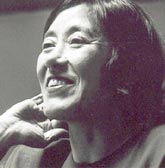
Mei-Mei Berssenbrugge, photo by Ann Hutchins
As a young woman, she attended Barnard College for a year before transferring to Reed College, where she received her B.A. in 1969 — writing a creative senior thesis that would center her life’s ambition on a career in poetry-writing. Receiving her M.F.A. from Columbia University in 1973, she then settled in northern New Mexico, becoming active in the multi-cultural poetry movement of the 1970’s along with her good friend Leslie Marmon Silko as well as Ishmael Reed, theater director Frank Chin, and political activist Kathleen Chang. Berssenbruuge taught at the Institute of American Indian Art in Santa Fe, where she co-founded the internal literary journal Tyuonyi. Traveling frequently to New York City, Berssenbrugge became engaged in the rich cultural flourishing of the abstract art movement, and was influenced by New York School poets John Ashbery and James Sherry, and then the Language poets, including Barbara Guest, Anne Waldman, Charles Bernstein, as well as artist Susan Bee.
While she has split her time between lower Manhattan and New Mexico over the years, along with her spouse, the artist Richard Tuttle and their teenage daughter, Martha, Berssenbrugge’s primary residence has remained rural Northern New Mexico. Winner of two American book awards, some of Berssenbrugge’s major poetry publications include The Heat Bird (Burning Deck 1983), Empathy (Station Hill, 1989), Sphericity (Kelsey Street, 1993), Endocrinology (Kelsey Street, 1997 — an artist book with Kiki Smith featured in the conversation below), Four Year Old Girl (Kelsey Street 1998), and, most recently, Nest (Kelsey Street, 2003). An edition of selected poems is forthcoming from the University of California Press.
1.
June 2003
We have just had lunch at a French bistro in my Manhattan neighborhood near 28th Street and Third. I tape-recorded the lunch — just in case Mei-mei Berssenbrugge and I said something brilliant over our salad or fish. (Replaying the tape of our luncheon conversation later, I would find a garbled cacophony of table-fork clicks and clacks of china, broken comments over whose salad was better — and did you want some? — and topics of conversation ranging from dogs to healthcare to husbands, and whether or not to order dessert.)
We have changed setting to a more serious venue, Starbucks, the one across the street from my apartment and that I call “my office.” The cassette-player on, I have just asked Mei-mei a question about her writing and its aesthetic history, in medias res, as if we had been talking about these issues sub-tabula all along. My question concerns the relation of Mei-mei’s writing to Theresa Hak Kyung Cha, and Cha’s revolutionary prose-poem book, Dictée.
Mei-mei Berssenbrugge: I’m trying to remember when I read Dictée. Before writing Four Year Old Girl, I was reading some of the cultural identity texts about nomads and the subaltern. I think Theresa Cha wrote this work before such studies became fashionable. When I read Dictée, her passion attracted me, but also the sense that she was carving meaning with each word in the moment, in a way that was almost sculptural, a physical art. I was interested in how she seemed to do that. It may have helped that she was multi-lingual. English was not her primary language. So she had a kind of triangulation on it, making the passion into something concrete. Her persona of someone who experienced a loss of place and a loss of culture I thought was beautifully expressed and something I thought I could identify with.
¶ Laura Hinton: Speak a bit more about that identification, going back to your own origins. You were born in China?
MB: Yes, I was born in Beijing, where my mother grew up. I came to the U.S. when I was one. I feel very strongly that my first language was Chinese — my mother tongue. All the linguistic structures were warming up in Chinese. I believe one experience that made me into a poet was switching from Chinese to English, because then you see everything is relational. I think of poetry as a set of proportions, equivalences. And you see that language consists of these equivalences.
¶ LH: So at the base of language you perceived early on this essential tension: of it meaning everything and nothing, that language is a rather mobile frame, in terms of referentiality. You believe that you intuited these aspects of language at a very early age?
MB: I had to get that understood, because otherwise, I wasn’t going to be able to express myself.
¶
LH: Did you go through a period of a certain loss when you made that shift in language?
Have your parents ever noted to you anything particular about this time?
MB: I don’t think my mother noticed, because we were going through our loss at the same time.
¶ LH: Let’s talk more about your poetry’s origins within the context of your own family of origin, and your early language discovery (and loss). Were you writing at a young age? How did you begin as a writer?
MB: My mother walked with me on the bank of the Charles River when I was 3 or 4 years old. The grass was thick with dandelions. I remember thinking, “These yellow dandelions are like a big yellow blanket.” This was a moment of revelation; I felt something amazing had just happened, which I can still feel today.
I identify with my Chinese family, a family of spirited academics. My maternal grandfather took the imperial examinations, then around 1912, and traveled to Boston to study at Harvard. His fellow class-mates in Boston included the Soong family siblings, T.V. Soong, and Madame Chang Kai Shek and Madame Sun-yat Sen. My grandfather eschewed politics and became dean of mathematics at Beijing University. He had given his land away before the revolution. My grandmother, from Suzhou, studied with her brothers at home, and in the early 1900’s insisted on a college education, for which she traveled quite far overland by herself. To protest Japanese occupation, my mother, a mathematician, walked 2,000 miles from Beijing to Chungking, where she met and married my father, who was in charge of the code room at the American Embassy at the end of World War II. After I was born we came to Berkeley and then Cambridge, Massachusetts, where my father took Asian Studies at Harvard.
I know I studied creative writing at Barnard, but the first poetry course I remember was with Galway Kinnell at Reed College. I think it was his first teaching job. He brought many poets to Reed, and they stayed at our house. So we had quite a poetry education. We had Robert Bly, Robert Duncan. We cooked and gave parties after the readings.
At Reed we were required to write a thesis and I had a mental block against expository writing. So I submitted some poems to Michael Harper for a creative thesis. When he accepted them, something mystical happened, [realizing] that my poems could be received in the world. Or that they communicated on a certain wave. After that, I lived for poetry.
¶ LH: This block about expository writing, can you say something more about that?
MB: I think it’s against whatever my brain structures are. And I can’t overcome that. I can’t write a paragraph.
¶ LH: Perhaps because expository writing represents a certain kind of linearity associated with a Western-type logic that your own style of poetry writing seems very much against?
MB: Yes, I think it’s the linearity — and also the voice. But I’m also interested right now in a type of discourse that is very direct and clear — “like” expository.
My friend Leslie [Marmon] Silko gave me a Courtney Love song, “I Want to Be the Girl who has the Most Cake.” It struck me as so clear and so simple.
¶ LH: Leslie Silko, by the way, is one of my favorite narrative writers — certainly my favorite Native American writer. But your work is very different. It’s very interesting that you two are friends.
MB: We’ve been close since the early 70’s. We have different aesthetics and different points of view. Very different experiences. She’s gifted at humor. The pueblo culture in New Mexico is sophisticated and civilized, and one of their instruments is humor, often understated humor. A purpose is to keep knitting the group together.
¶ LH: Her aesthetic is chiefly driven by the storytelling mode. It’s plot-centered and descriptive, engaging in those traditions of narration. I think of your poetry as dealing with perspective. There is some description there, but any description of “reality” is marked by the issues of perspective, the shiftings of perspective — as if you’re dancing around different problems of perspective and never satisfied with one way of looking at a landscape or objects in space or relationships with people. And that is quite a different thing than, say, a brilliant story about Native American life in a book by Leslie Silko.
MB: That’s where I think changing from one language to another set me on my course. But Leslie is a major influence. We met at a writing conference when we were in our 20’s. She describes an ethos with many different layers of reality and irony. Also, Leslie gave me my first book of philosophy, Wittgenstein’s Remarks on Color, which she had received from her friend, Larry McMurtry. She started me on a journey: first Wittgenstein, then 20th century French philosophy, then dialogues with Robert Nozick, and, later, Gayatri Chakravorty Spivak, with whom I studied. Parallel to these investigations was a passionate involvement with the light, culture and landscape of northern New Mexico, where I have lived since the early 70’s, and my experiences with Georgia O’Keefe and Agnes Martin.
¶ LH: One of the things that attracts me about your poetry is its interest in color, and the ethereal desert-scapes that appear and disappear, rise and fall with the light, desert which I became deeply connected to as a child growing up in the American West. The subtle — and I would add, philosophical — registers of color of the desert permeate much of your poetry. There’s always this issue about light and color. It’s almost as if you are making a visual effect, but it’s a verbal one. I experience the visual that way in your poetry — almost in a primal way, not a “translation” effect, through language. This authenticity and yet complexity very much attracts me to your work.
MB: Looking at the landscape of New Mexico was central to me for a long time. In my book, Nest, the visual is not as prominent, although I wouldn’t mind if it came back.
¶ LH: Let me now ask you a slightly different set of questions. In Rae Armantrout’s essay, “Feminist Poetics and the Meaning of Clarity,” she argues against the idea that women writers are less experimental and more traditional by nature, that they supposedly need more plot and narration in order to describe the conditions of their social oppression. Rae argues against that point, which had been suggested by other writers — all of them men, I think — saying that women are actually very attracted to an experimental kind of writing that rebukes this set of conventions. She questions the “meaning of clarity.” This has to do with the poetic discourses of the academy, the institution of “Creative Writing,” people studying Contemporary Literature, the mainstream forms of modern writing. She suggests that women are instinctive “outsiders” to these conventions.
MB: Yes, I would even say that women have an essentially more fragmented approach to writing. Just being the outsider gives you more freedom to see the fragments.
I remember years ago Kathleen Fraser saying that women with children have to do this and that — it’s more natural for them to pay attention in fragments. I’ve heard people say that to portray fragments is actually more naturalistic. If we sit here, for example, and people walk by talking, and you record what we say and they say in patches, that’s actually more representational than a single narrative line.
¶ LH: So going back to this issue of “clarity.” Take the writing of Leslie Silko, for example. Her writing is following those traditional representational structures that are considered part of a “clear” reader-writer contract, right?
MB: I wonder if that, for her, is really part of her social commitment. She has a deep commitment to people without power. Also, I question the word “traditional” as applied to Leslie. The clarity of her narrative line may not be of a tradition we are familiar with.
¶
LH: Well, that’s the argument that Rae Armantrout is countering. She’s actually responding to her friend Ron Silliman’s argument, that women, like other oppressed groups of people, need the conventions of narrative to speak at all. She says that we, as women, have a connection to alternative rather than conventional terms of discourse, which may be patriarchally-ideologically infused and inescapably so. That women have a different relation to the symbolic. What is your own position on this? In your writing, where do you see yourself? Because I believe that you, too, are a socially aware writer, on many different levels.
What you are doing with perspective is very political for me, because perspective is situational, and that shifting situation is the nature of politics, whether you’re in a room of people in some kind of institution, or any group, or the family — maybe I’m answering my own question —
MB: I like what you’re saying.
¶ LH: Where do you position yourself with regard to “the group,” politically? And what kind of relation do you wish to build with your reader?
MB: I have deep feeling for the group, deep longing, and I have inner-drive for my work. Generally, I’ve let my inner-drive dictate what the next moment will be. I trust that inner drive’s assessment of the reader. At the same time, I want to be open to and express the situation of my culture. I feel that audience extends out like a web. A reader can carry the influence of my poem to another person without that person necessarily knowing the poem itself. I also feel karma works in the proliferation of one’s influence or expression.
But I don’t think understanding is that important. I think there are mysteries. Things can set other things in motion that can set yet other things in motion. Without understanding.
2.
October 2003
Mei-mei Berssenbrugge has just given a public reading at the City College of New York, where I teach. Now we are sitting around two large tables, with about 20 other people, most of whom are young men and women, aspiring writers or teachers in New York City, students of my graduate class, “Women’s Experimental Writing.” There are also a couple of notable “outsiders” present. Elizabeth Frost is seated there. And, near Mei-mei, but at the periphery of the circle, is her husband and collaborator, the artist Richard Tuttle.
It is after 7 p.m. and it is a chilled fall evening. We don’t notice much about the weather in this huge concrete “bunker” on the large hill at Amsterdam and 137th Street they call the “NAC” (North Academic Complex). NAC is so huge, it has its own climate. Tonight the room here in NAC feels warm, buzzing with the vibration of Mei-mei’s softly spoken, and yet deeply moving and articulate, reading a few minutes earlier.
LH: One of the things we’ve been discussing, Mei-mei, in class, is the use of the term “experimental.” What does it mean? It’s in the title of our course here at City College. But how do we define “experimental”? A lot of us are bothered by this term — and yet we use it because we lack another term that can identify a writing that works against tradition. (The term “innovative” is sometimes used, but it also seems problematic.)
We read your book Empathy as a class assignment. Your work is an interesting case in terms of being “experimental.” Which it is, and yet, the work doesn’t fit neatly into any such category of “experimental” as currently available to us. In class, we talk about the way “experimental” writing really should confront readers with what we understand and do not understand. We spoke last time together about Rae Armantrout’s essay on “clarity.” She asks this brilliant rhetorical question: “Is the world clear?” No, the world is not very clear (it seems increasingly less so). How do you define “experimental” in the context of your poetry? When your work is included in classes like ours or in books that use the term “experimental” (like the book I co-edited with Cynthia Hogue, We Who Love to Be Astonished, on experimental women’s writing practice), do you feel the term properly registers some quality in the nature of your work?
MB: I’m generally delighted to be collected in these books because I like my company. But I had a friend who said, “I’m not an experimental artist because I know what I’m doing.” I have a natural interest in new forms because I like to follow where the energy goes. If something loses energy, then you try to find a form that embraces where that energy went. Eventually, this kind of work will no longer be called “experimental”.
One thing that would qualify my work as “innovative” is my interest in abstraction. I explore abstraction in poetry. Richard [Tuttle] was describing a Goya painting he saw the other day — the little boy in a red suit with a birdcage on one side and a cat on the other. There’s a sense that this is a representational painting, boy, birdcage and cat. But Goya selected and placed that birdcage. Why did he want that there? The cat and birdcage create a kind of abstraction. They are formally innovative objects you can recognize.
¶ LH: Here’s a question that one of my students would like me to ask: “Would it be possible to write a meaningful experimental poem today without dealing with a dichotomy of the self?”
[The student, Mimi Allin, gives additional clarification, suggesting that the “dichotomy” is the “female” self, which has a different exterior from interior, and which she finds is part of women’s experimental ethos as structural reflection of women’s social condition.]
MB: You mean a kind of unity? I have an ideal that there exists a poem like that — the way a bird opens its mouth and sings. Even though I can’t “sing”, I imagine that’s possible. But also with inside and outside, woman and not-woman — these don’t necessarily need to be dichotomies. They can also be continuities.
¶ LH: So what do you feel is your principle goal of your work in terms of this “unity,” aesthetically?
MB: I would say the ethos and aesthetic of my poetry aspire to be holistic, continuous, or one thing. I intuit an unknown edge of alive language exploring a question, perhaps an existential question, but to which is attached strong feeling. And perhaps this can become a beautiful, formed energy nexus of a poem.
¶ LH: This is going to lead me to a question that jumps well beyond my imagined trajectory of questions, which once had a linear logic — a false logic. I recently saw Leslie Scalapino in San Francisco.
MB: She is a good poet.
¶ LH: I mentioned to her that I had been reading a lot of your work, and that you had also told me once — maybe a year ago — that people had been telling you and Leslie that you had much in common as poets —
MB: — when we were young —
¶ LH: — yes, and that you and Leslie encountered each other, and told each other, humorously, that it wasn’t true, that, in fact, you were very different kind of poets.
MB: Yes, we said, “I don’t think my writing’s anything like yours!” [Laughter.]
¶
LH: So in my recent conversation with Leslie, I said to her that I do think there’s something in both writings that’s evocative, one of the other. Yet I couldn’t identify what it was. Leslie told me that she agreed, that both of your poetries are interested in perception, and that they suggest an “inside and outside” existing simultaneously at once, that there was a sense of simultaneity in the writing and its object.
I thought to myself, Yes! That is a facet of the writing that makes both poetries so revolutionary, to a Western sensibility, at least.
MB: We are both influenced by Asian philosophy. [The non-Western] is something that we identify with. Also, we’re interested in phenomena. I don’t know if that’s the same as perception. I think she’s more explicit and, actually, successful [about her dealing with phenomena]. But we each also connect that phenomenology with Asian timelessness. Each of us is socially committed, so we put that in the work, as well.
¶
LH: Almost as if the work — and this is going to sound a little glib — is anti-patriarchal, or certainly anti-capital in the way it refuses commodification. The work is produced out of this multiplicity of vision that refuses to be a commodity served up on the market menu. (This again goes back to the issue of “clarity.” What is “clear” is what we are used to perceiving as “clear,” according to marketplace value.)
About the timelessness: there is that alternative sense of time and space that infects the structure of the poem/ poetry series itself. To extrapolate a piece or a line from your work — in the work of either one of you — you just can’t. It’s part of the timelessness of the “series.”
One fascination some of us writing scholarship have — Beth [Frost] is on the frontier of this work, and I’m beginning a book about it now — are hybrid genres, those kind of poetries that can’t be defined by traditional categories of lyric, or narrative, the ballad, the epic — which are supposed to be so distinct. In my book manuscript I’m calling this kind of poetry work “intergenre” writing, which is kind of a poet’s prose, and yet more. Harryette Mullen, in an interview with Cynthia Hogue, has called it “the mongrel text.” Mullen’s idea of this kind of hybrid poetry is that there are different registers of language, cultures — high and low — spliced and interlaced together textually. For example, in her book, Muse & Drudge, which our class just read, we noticed the use of the Greek poet Callimachus (c310–c240 B.C.) next to Sapphire (Sapphire Stevens, a figure from the popular radio and television show “Amos & Andy,”, 1928–1956) as well as uses of the Greek poet Sappho. And we noticed the movement in and out of languages and registers of discourse, like the blues.
Since your book Empathy, you also seem to be writing a kind of hybrid “poet’s prose.” The writing remains very lyrical and yet breaks from lyric tradition at the same time by these interruptions through hybrid texts. I am fascinated, for example, by your use of the word “et cetera” in your recent book, Nest. It leaves “lyric” diction. And there are other colloquial, speech-like elements in your newer poetry. You pay attention to the way it might be spoken and heard. How do you perceive your poetry as “hybrid” text, as a type of writing breaking down/ re-combining literary genres and discourses?
MB: One of my subjects is culture, the fabric of our experience of contemporary culture. I was close to the early multi-cultural movement in the 1970’s. Ishmael Reed influenced me a lot. He championed using brand names and gossip in fiction. I learned to ask: where is the inherent interest? Some things are just more interesting than other things. I guess I wouldn’t call the poetry a hybrid, because I like to think of it as one kind of surface. Now people take parts of things and a text can take its meaning from its context or its intention. It’s a more complicated world now.
¶ LH: You’re describing post-modernism in a very eloquent manner.
MB: Yes. I don’t like to call it “post.” There’s something very complicated about textures now, and they are not about a single set of values or a single point of view or a single voice.
¶ LH: It seems in modernism there was still some kind of belief in the authenticity of the self or the singularity of self. As Mimi [the student] was noticing, in the poems we are reading, there’s no longer a care for the authenticity of the origin, or the beginning point. The voices are interwoven. In your work, by the way, there are many enticing threads of narrative that allude to “a self” in your work, very magical and very real, about perception and relationships, domesticity and houses.
MB: It’s made up. There’s the narrative, for example, in “I Love Morning”, where everyone in the house is waking up, and there’s a girl named Martha who has a cat. My daughter’s name is Martha, and the story drives her crazy. She says, “Everybody’s going to think I have a cat.”
I try to make a unity between thought and emotion, or, perhaps, expository and narrative, the lyric and the non-lyric. I feel that narrative is a sacred form with deep power.
Technically, my poems are collages. The parts are appropriated. While reading, I copy down notes, then cut them out and put them together in a collage, smoothing out the grammar. So it interested me that a sick cat and a woman with large arms could come together as something resonant. That is the kind of narrative I deal with in Nest. I call it a linguistic surface. If you’re going beyond modernism, in many ways you’re going beyond a three-dimensional space. I don’t like to call it hybrid, because I like to think of it as one thing, a continuum.
¶ LH: With Arthur Sz in Santa Fe, in an interview from the early 1990’s on video-tape, you talked about your creative process. You talked about the way in which you use a collage method, including photographs, laid out on a big table. Are you still working in this manner, as, say, in Nest?
MB: I was interested in the minor mode when I started the poems in Nest, instead of a major, victorious tone. I was interested in the shadows, the not-quite-successful — to re-cast failure as convex, positive. There’s a poem called “Audience” about a depressed Japanese anima artist. I had the urge to explore this minor key and also to include the audience. I used to think only of what I wanted to write. In Nest, I started to think about my audience, what I call the genius of the audience.
It seems obvious that American culture is betting on this genius of the audience. It’s a kind of commercial bet. I was interested in not looking down on that and seeing where I could go. I’m trying to discern what people like. Maybe that’s what I call this “genius”. Perhaps because I was trying to think about the audience in Nest, I used more narrative.
My process has evolved slowly. Everyone is busy; one can’t just sit down and write with concentration. Or I couldn’t find that concentration. So I’d first seek my idea for a poem, for example, for the title poem “Nest.” I decided to write about how, in the margin, fertile things happen. When things are fixed, things can’t grow. But in margins, things grow. Then I find books that are contingent to my idea. I like French philosophy, Deleuze, Derrida. I like Buddhist texts. Anything I read that strikes me as pertinent to my poem I underline. Then I print the notes and cut them out. I add pictures that seem to me pertinent in some way, without questioning too deeply. Sometimes I take Polaroids. It’s an unconscious process. When I’m ready to write, I arrange these pieces of text, photos, notes across a big table and compose the poem. I used to appropriate texts directly. Now I tend to alter them. I work from a map of the poem, and I find it’s a good way to get more breadth, more horizontality.
¶ LH: Do you find you’re walking around doing something, an errand, and you get a line in your head and you jot it down, and it ends up on your table?
MB: Not very often. Usually I consider all fragments the same as the whole, like holograms. But one day, looking at the horizon in Utah, I said: “Where sky touches the ground is not the same as the whole.”
¶ LH: I am fascinated by margins, and your idea of the productivity of margins, that in-between space you described in the poem, “Nest.” Likewise, in the poem, “Empathy,” the beginning line, which reads in italics, says: “what touches me is where the inarticulate, the error or tension finds concrete manifestation and is recognized.”
MB: That is a quote from a wonderful poet, Beverly Dahlen.
¶ LH: You were saying that in the book Nest, as a whole, you were concerned about audience, and yet there’s something in the breakdown of communication, or “rupture,” like margins, that happens. And can’t we just hang out in that space?
MB: It is most productive. I guess if you know what you’re doing, you’re not in a good space for art.
I’m grateful for my profession. I don’t think artists are happy with the world and they feel a need to make another world. So you’re at the edge, trying to make this world. It’s more about resonance, frequency, energy, movement, flux, dynamism, than any fixed object. So we call that margin or error or misunderstanding. But that’s because human beings want to achieve. You could also take those qualities we find in shadows, in misheard remarks and give them positive terminology.
¶ LH: So you think there is a kind of pejorative understanding of margin or error or being the space that doesn’t count — ?
MB: — wandering.
¶ LH: Certainly the model we live with is to march ahead, and to imagine that everything is clear, and also that everyone has universal value and understands everything the same.
MB: Fertility — that’s not a pejorative word. And it’s also a kind of unformed area of flux.
¶
LH: So to use a culturally feminine model, fertility, is to feminize the margin or the error? In our class, we’ve been looking at how women themselves are appropriating that space of “error,” the margin, and doing something different.
[Here another student asks a question about the importance of Mei-mei’s life in New Mexico to her work.]
MB: New Mexico has been important to my work for a long time, since my early 20’s. It helped me to think about the horizontal plane of meaning, because its landscape is so large. Also, it correlated with my interest in phenomena around me, because the light is always changing and you never get used to it. It’s beautiful and spiritual.
Also, I was a hermit.
In the late 1980’s, I felt the need for a child. I started working on a book with Richard Tuttle at the Whitney Museum. I say, I would have married anybody, but I was lucky. Richard and I are hermit personalities. When you’re young, being a hermit allows you more concentration, which helps writing. On the other hand, as the great theater director Peter Brook said, the most important things we learn in the presence of other people. It becomes a balancing act.
I am Chinese, and my family is my essential life metaphor. Dialogue with Richard informs all my work since our collaborative book Hiddenness and has extended my experience of the visual more than I can say. Martha Tuttle [their daughter] bravely and indefatigably opens my view ahead. One of my themes is the possibility or impossibility of connection with others. Many poems show the richness of this possibility with my family.
¶ LH: A final question. Much is being written today in critical circles about contemporary experimental writers’ transformations of the lyric, particularly about women’s participation in that transformation. Do you feel that you, like many other contemporary innovative or “experimental” women writers, are contributing to a new form of the lyric? Or do you see more of a continuum, say, from the nineteenth-century Romantic tradition (that of Wordsworth, for example, or of Shelley) to the twentieth-century modernist tradition (represented in Anglo-American terms by Pound, Eliot, Williams, HD)?
MB: I don’t identify with either of these traditions. If I had ever thought of my intent, it may have been about writing in a way where time is simultaneous across the surface of a poem. I might say I want to express the qualities inherent in my voice I was born with. Also, that I’m naturally inclined toward sensual beauty.
Now, I suppose I am trying to find a resonance in a poem beyond the single author and beyond the outline of the individual poem.
3
December 2003
The setting is the roomy loft apartment Berssenbrugge shares with Richard Tuttle and their daughter, Martha, in Lower Manhattan. The white walls are hung with Tuttle’s spare but beautifully colored canvases; the few pieces of simple-lined furniture are his works, as well. I sit next to Berssenbrugge at the only major fixture in the room: a long marble table, empty except for a pile of papers and books. One of the books is Hiddenness, the artist’s book by Berssenbrugge and Tuttle, which was commissioned by the Whitney Museum and published by the Whitney Museum Library Fellows in 1987 (120 copies). Another book is the artist’s book Endocrinology, Berssenbrugge’s collaboration with visual artist Kiki Smith, produced by Universal Limited Art Editions in 1997 (40 copies) and co-published in a smaller paperback format by Kelsey St. Press.
LH: We’ve talked about how collaboration is very important to you as a poet, that you’ve worked with artists in theater, dance, as well as visual artists — including your husband, Richard.
MB: For me, collaboration has been a wonderful way to open to someone else’s sensibility, to use that openness like ocean or oxygen. Also, I’ve used experience with the other arts to discover ways to make formal changes in my own poetry.
¶ LH: Have you ever collaborated with another poet? I know many experimental poets for whom collaborations with other writers is very important — poets who like to work together in group pieces. For example, Ron Silliman has recently collaborated with Rae Armantrout; Lyn Hejinian with both Leslie Scalapino (in their book Sight) and Carla Harryman (in their manuscript under consideration, The Wide Road). Some writers work collaboratively now by e-mail. Is that something you have done or would like to do? — because you seem to be more drawn toward collaborative work with artists in other media.
MB: It’s true. I guess I wouldn’t get the same “oxygen” working with an artist in my own field. I did begin a project with another writer when I was younger. It was fiction. We were going to pastiche — to model — the whole book after four beginnings of other books: one, for example, was La Vita Nuova, and another was The Journals of Lewis and Clark. It was interesting, but it was never finished.
I want to show you a copy of the book Hiddenness.
LH: Had you two met before you created the book together?
MB: No. Richard was looking for a poet for this project for about a year. He went to local bookstores and looked at every new poetry book they carried. He didn’t know about the small press, that small press books can be more vital or contemporary.
¶ LH: “Vital” — because they are non-commercial?
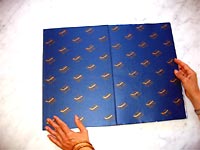
Figure 1
MB: And not academic. Then Bradford Morrow, the editor of Conjunctions, showed Richard work of mine, and he agreed to meet me — and we began our collaboration.
¶ LH: So we’re looking at Hiddenness.
[Berssenbrugge has placed the book on the marble table, opening it to the end pages in dark-blue, printed with golden crescent shapes . (Figure 1).]
MB: I think of this blue color as night. The blue is organic dye — real indigo — the same color used in blue jeans, which looks so beautiful next to the skin of your hand. There are two different kinds of gold: one is silkscreen, the other is lithograph. Part of the effect of opening up the book is of having light pour out.
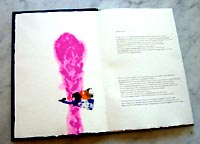
Figure 2
Looking at Page One (Figure 2), you experience three planes. You have the plane below the surface of the page, where the letters are literally pressed in or incised into the page. Then you have color thrown into the paper pulp as it is being made that forms another plane of the surface of the page. And third, the page is hand-stamped, above the page surface. Subliminally, the book is working with three experiential levels. (Figure 3)
¶ LH: These levels include the literal dimension of the text. The text appears to have its own dimension.
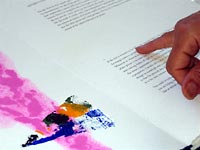
Figure 3
MB: The text uses the idea of hiddenness as a metaphor for emergent light, the way the physical book opens to the luminous first page, or the way representation or an image can shelter or “hide” spirit-light. These lines are beside the first image: “You could be hiding behind pane of glass in the atmosphere, or an example inaccessible to what/ you are hiding, the way the beauty of a person, perhaps during a daydream, may flash across your mind,/ like an animal across the landscape...”
Another formal characteristic is how blocks of text are laid out across traditional margins. The blocks of text are placed carefully but without regard to page margin or gutters — so the space of the text is “freed.”
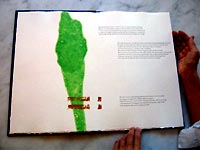
Figure 4
¶ LH: Now these images shaped like mushroom clouds — explosive plumes of color, like energy rising out of the ground and into the air — pink on the first page, green on the second: what compositional method creates these cloud-like figures? (Figure 4)
MB: These shapes are colored pulp thrown into the paper as it is being made. Richard supervised the papermaking with Paul Wong at the Dieu Donné Papermill. The colors are of the paper.
There are several types of hand-stamping. Two organic blacks in the visual motif are achieved from burning two different kinds of wood. (Figure 5)
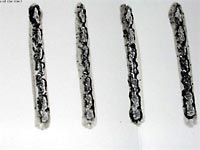
Figure 5
¶ LH: So I see where the ash was burned into the ink. It has a dimension, like a painting has a dimension from the paint itself.
MB: The lines are: “If one string line of a bone crosses another properly, an area of brightness or intensity is created, so/ that a skeleton, because it was hidden, appears to have been exposed, almost inadvertently in the stance of a young boy...”
¶ LH: Has this book been otherwise reproduced? Is it available in any other form from a press?
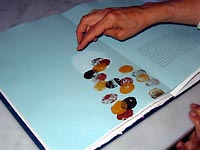
Figure 6
MB: No. But the poem of Hiddenness was published in my book Empathy — there it’s called “Honeymoon.”
Here the bleach circle (Figure 6) is of the surface of the paper, and the brown and gold image is hand-stamped above the surface. “The light is so bright/ its volume would be a source to see whiteness from, which falls on a hand or on jewelry differently.”
We tried to make open space on the last page anchored at the left by the conventional margin, and opening out to the right, without impediment.
¶ LH: I see here are the credits. Richard is calling himself “the illuminator.” (Figure 7)
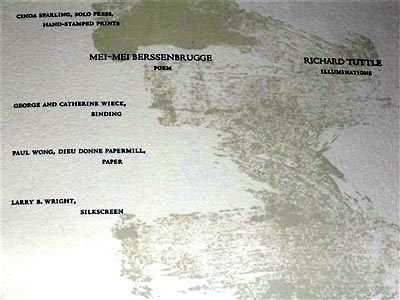
Figure 7
MB: I called him “the illuminator.” Before we started Hiddenness we looked at medieval illuminated manuscripts at the New York Public Library. There’s not a direct correlation between text and image; it’s more as I said bringing light or illuminating some essential spirit that had been sheltered.
¶ LH: So the experience of putting Hiddenness together then brought you together as a couple?
MB: Yes. We had an intense dialogue. I collaborated with Richard and we married. Then I collaborated with Kiki [Smith] and our work and lives have been intertwined ever since. I’m wearing her gold bracelets.
She demonstrates the accordion binding of Hiddenness by opening the book to stand on its own as a kind of folding canvas. (Figure 8)
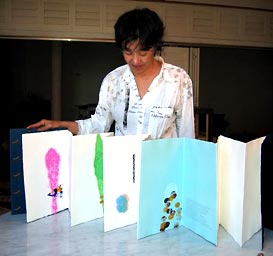
Figure 8
Berssenbrugge now turns to the artist-book version of Endocrinology, lifts it onto the table. It is large — 2” x 2 square”. This copy is one of the original 40.
MB: My publisher, Rena Rosenwasser, at Kelsey St. Press, asked if I was interested in making a book with a visual artist, but I didn’t really know anyone I wanted to work with.
Then Richard brought me a catalog from the Institute of Contemporary Art in Amsterdam of a show by Kiki Smith. He’s actually known her since she was 13, because he was a friend of her father’s, the sculptor Tony Smith. I called Rena about Kiki and she said, “Oh, her dealer is right here in the room with me!” So then we called Kiki. I went to New York to her place on Ludlow Street, and we met. Then she came out to New Mexico for the first time. And she’s been coming to New Mexico ever since.
She’s one of the artists credited with bringing the physical body back into art — as imagery, as subject-matter, after a period of abstraction —
¶ LH: — in which the body was not part of representation...
MB: ... was absent!
MB: That’s one reason I was interested in her work. I thought that, since my work is so abstract, I could use dialogue with her to find my way into a more concrete kind of narrative. She suggested that our book might involve turning black organs white ,or getting light into the organs. I thought that was a terrific idea, because I was sick at that time.
¶ LH: I am fascinated with Endocrinology because of its use of the body, precisely, and the relation between the body parts and the text parts — and the exchange of both elements on the paper. And also because of the experience I have of reading it, as a sort of initiation into healing. When you created this book with Kiki, you say you were experiencing a time of illness. I wonder about Kiki’s own relationship to the physical issue. Was there any health crisis in her life that informed her creativity, as well?
MB: The correspondence is perhaps that she had just broken up with someone, and that she was thinking of creating physical light inside the body. She was raised as a Catholic. Her body is a tangible way to represent the spirit.
So she visited New Mexico, I went to New York, and meanwhile we’d have conversations and I took notes. I’d go to her shows and take notes. If she happened to read something, I’d read it. I chose a list of words from the notes and I threw out words to her and she’d throw words back. When asked about this time, Kiki has said, “Oh, it was great. Mei-mei would ask me a question and then I’d cry.” I was gathering material.
¶ LH: Well, you made me cry — at the end of our first interview.
[Laughter.]
MB: I don’t remember what I said.
¶ LH: It was your comment about audience and the reader, about “understanding” and its “mysteries” — it literally shocked me into a new awareness, on some existential level. You have a way of asking or saying things that penetrate quite deeply. What you said had provoked this felt emotional response, so the tears were completely involuntary.
MB: I think that’s what poetry is. If I could do that in my work forever —
Kiki told me about the medical textbooks at Barnes and Nobles. So I read books about the immune system, the endocrine system.
¶ LH: Were these systems at the center of your own body-health issues?
MB: In fact, my issue was the immune system, but Kiki was interested in the endocrine system. For example, she made a beautiful figure, a statue whose arms were very long, another woman with facial hair. This figure was really about the form of the body.
¶ LH: Doesn’t the endocrine system control the hormones?
MB: Yes, and the hormones control everything. One of my subjects is the continuum between material and immaterial. The endocrine system is like that. It can rely upon just one molecule to make a change. It’s material, but it’s so close to being immaterial.
¶ LH: So you studied the Western medical versions, the scientific treatises, on the human body, and did that kind of research-investigator’s work before writing the poem?
MB: Yes. I liked the analytic structure and language of these descriptions. I used them in syncopation with the intense emotionality of the work.
¶ LH: This concept of endocrinology — I have to say it’s a mysterious aspect of medicine and the body’s system for me.
MB: Well, only scientists call it a “system.” It doesn’t call itself a “system.”
¶ LH: Why did you choose these kinds of classifications for discussing the body? Were you interested in going into any alternative-medical methods for describing the body, say, through Chinese medicine and acupuncture? I know that Dictée is an important work for you, and Theresa Cha does an interesting job of juxtaposing these different culturally based medical systems. Instead, you arrived at a predominantly Western channel for exploring the body as a text. Why did you choose the Western way?
MB: Everything I do write presumes an East-West dialogue. When I use textual sources, I usually include both East and West. I don’t remember my other sources for Endocrinology.
¶ LH: As we’re talking, I realize that what you’re doing in Endocrinology is actually dismantling the Western approach.
MB: That’s right. It’s considerably transformed.
Kiki made monoprints of organs from the endocrine system. When she was in New Mexico she rented a little house, and I visited her. She talks a mile a minute, and she’s always using her hands — while she did this, she made the prints for the book. Then she lost them. Then she made another set and she left it on the train. By now I was wondering about her commitment to the project. Anyway, she did finally deliver beautiful, evocative blue prints.
She decided she was interested in a highly produced artist’s book. Kelsey St. makes beautiful books, but they are paperbacks. Kiki asked U.L.A.E.(Universal Limited Art Editions), whose director, Bill Goldston, is a great printer, a great muse and a cultural hero, to do the artist book. He and Kiki had worked extensively together.
I think she chose this rice paper because it has a skin quality. It’s tougher than it looks.
I wrote the poem with five stanzas. We started cutting my stanzas into lines, first at a bar on Ludlow Street, then at my loft. I was tired of writing very long lines grouped in stanzas that had to be printed sideways on the page. With Kiki, I found my way to a different arrangement of text on the page.

Figure 9
¶ LH: So you literally cut and paste the poem into the book?
MB: Yes, literally. We cut and pasted with scissors and scotch tape and, in about 20 minutes, made the maquette. U.L.A.E. elaborated our production. They reproduced my xerox with letter press, our handwritten words with silkscreen and the cut-out text strips as die-cut templates.
¶ LH: They reproduced your xerox maquette exactly as you had originally produced it?
MB: Yes, layering exquisite technique and many production hours into the final product.
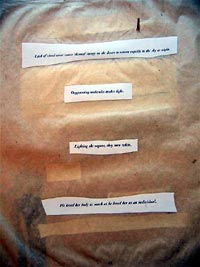
Figure 10
¶ LH: So this flowing quality in the book which looks like a child has been cutting and pasting, the putting of the book together in this ragged way is —
MB: — actually highly produced. I think they succeeded. We made a book that we cut up. And they took that book and produced this copy. (Figure 9)
¶ LH: Why the appearance of “handwritten” words? (Figure 10)
MB: It introduces another texture to the physical object.
¶ LH: I’m reading the words “tongue,” “shoulder as I look through the book. (Figure 11)
MB: Remember the lists of word associations? We chose pairs of handwritten words and added them to pages with printed text. We were trying for other textures, layered like the human body upon its own transparencies. Throughout the book, you can see an image on one side of a page show through to another. Like a body, having different realities that you can see.
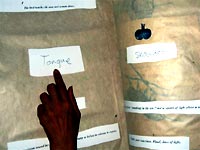
Figure 11
¶ LH: This reminds me of Erica Hunt and Alison Saar’s book Arcade, with its verbal-image transparencies. But this artist book book predates Arcade (also published by Kelsey St. Press), I believe.
MB: Yes. It could be something that was in the air. Here is “hairline,” “fat”.
¶ LH: This image of Kiki’s looks like a woman’s uterus to me. (Figure 12) It seems to have a motion to it, almost like a graceful rendition of the fallopian tubes. The figure also provides a good example of a counter image shining through the paper.

Figure 12
MB: And this one represents the glands of a breast.(Figure 13)
¶ LH: The text from your poem, on the opposing page, accompanied by a mirror image of the breast, reads: “... their systems associate like writing, knowing edges of a system and areas in between, an outpour of molded sand/ with iron rocks in crevices, as in a story she accepts not knowing if her lost child is alive.” Those lines are mysterious and very beautiful.
MB: You picked the most ponderous sentence in the book!
¶ LH: I am fascinated by both the poetry and the mirroring breasts.
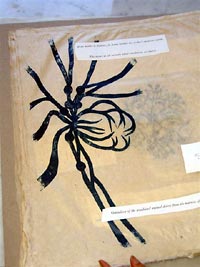
Figure 13
MB: Yes, there’s a lot of mirroring. Because parts of our body are twinned.
[Berssenbrugge leafs through more pages, pointing out other visual images.]
MB: This might be the pancreas — and here are the adrenals. (Figure 14)
¶ LH: But I see that you purposely did not put an image of a particular body part next to a poetic discussion of that body part.
MB: No, I’m not representative.
Here are some lines: “The woman leans on the table, forearms abnormally long./ Her milk flows and flows. She cries and cries.” These lines specifically describe Kiki’s works. She has a sculpture in which milk appears to be flowing and flowing from the breasts. Another figure pouring with tears — then here are following lines: “These are unaccountable imperfections in the numerical fabric, not mysteries. A wire crosses in front of a line on the wall, while its shadow seems to cross behind it.” These lines were based upon a wire work by my husband.
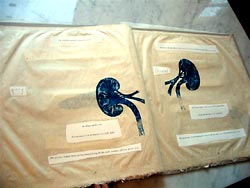
Figure 14
To me visual art often expresses new ways of looking before they appear in poetry. Here — “Touching a wall produces the sound of touch on another wall” — describes a work by Bruce Nauman. It’s appropriation.
¶ LH: Is that a form of found language?
MB: Everything I write is found language, somewhat altered.
¶ LH: How are we to read the “handwritten” words? For example, on this double-page spread with the poetry text inspired by Nauman’s work, the “handwritten” words are “resignation” and “center.” How do you choose your juxtapositions of words/ text/ image?
MB: The words are placed more or less in at random.
¶
LH: In your poetic lines, you begin using a regular rhyme pattern in the book, something you rarely do in writing poetry. Usually your poetry lines, while having a great musicality, have a sense of free verse or poet’s prose; they do not rhyme in any traditional way. Here, through rhyme, you create an interesting symmetry, especially at the end, as if you’re pulling in all the fragments and pieces through this musicality, referencing a kind of synthesis through harmony.
And then we see a blemish on the paper that calls attention to itself visually, amidst this very regular poetic scheme — almost as if in visual contradiction to what one “hears.”
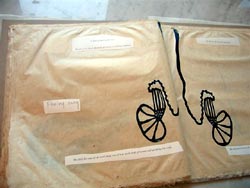
Figure 15
MB: The end of the poem was sensed. It went rapidly, and perhaps that creates rhymes.
¶ LH: In other words, there’s a kind of momentum that builds up toward the end of the book?
MB: Yes.
Here, near the end, is an image of the testicles. (Figure 15)
¶ LH: Up until this point in the book, I was under the impression that it focused on only the female body. But this is not a book about women.
MB: No. We’re both quite woman-oriented. But the book is not about women.
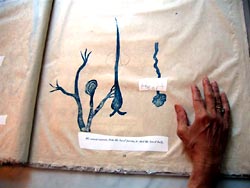
Figure 16
One thing I love about this book is the Kelsey St. Press facsimile. The U.L.A.E. edition is very expensive, so many hours went into the production. The paperback “facsimile” has a completely different effect. But it’s good.
¶ LH: You end the book on the scripted “handwritten” word, “heart.” (Figure 16) The text that goes along with the word “heart,” as icon, reads: “There’s an engine.” The heart is, after all, the body’s “engine.” This placement of word-icon and text does not appear to be completely arbitrary.
MB: But it was random —
[Laughter.]
¶ LH: These are lovely last words, the text at the bottom of this final page: “He cannot separate from the loved person, to shed the loved body.”
MB: Richard [Tuttle] says that a book is like the body, that it is a metaphor for the body. A book has a spine, and its cover is like the skin. And it has a heart —
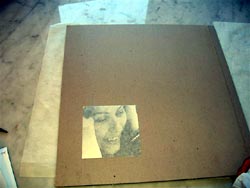
Figure 17
¶ LH: That’s so interesting. Because in spite of our use of computers today, I can’t imagine giving up the “book” as physical object. I love books. I love reading them and holding them. I’d never heard that explanation of why one might literally desire books.
MB: I think Endocrinology can be seen that way. On the back and front of the book, you have a photograph of each of our faces. That was Kiki’s idea. Even though I was unsure about these photos, I think it works. On the cover and back of the book, you see faces and smiles. Then, you have the abstract turmoil of the interior.
Berssenbrugge closes the book and shows me the cover, with the inset corner photograph of Kiki Smith. (Figure 17) Then, she turns to the back cover and shows me the photograph of herself. (Figure 18)
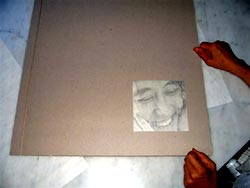
Figure 18
LH: These are beautiful images of the two of you. Your images are like twin mirrors; once again, you are asking us to see the body in its duality, its mirror-image.
Thanks to Elizabeth Frost and Cynthia Hogue for commissioning the original series of interviews for their edited collection, In Her Own Words: Postmodern Women Poets (Works and Interviews), under consideration at the University of Iowa Press. A selection of Part Two of these ‘conversations’ is also forthcoming in The Journal of the American Academy of Poets (2005).
it is made available here without charge for personal use only, and it may not be
stored, displayed, published, reproduced, or used for any other purpose
This material is copyright © Laura Hinton and Mei-mei Berssenbrugge and Jacket magazine 2005
The Internet address of this page is
http://jacketmagazine.com/27/hint-bers.html
